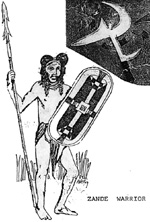 The announcement of the up-coming release of Azande
figures by The Foundry, has caused me to dig out some old
research notes and combine them with the information from
my old Savage and Soldier VII #3 article on the Force
Publique. The Azande are called the "Zulus of the Congo". I
think a colonial wargamer will find that painting up an
Azande army will result in .owning a force that can be used
in a variety of situations against a variety of opponents.
The announcement of the up-coming release of Azande
figures by The Foundry, has caused me to dig out some old
research notes and combine them with the information from
my old Savage and Soldier VII #3 article on the Force
Publique. The Azande are called the "Zulus of the Congo". I
think a colonial wargamer will find that painting up an
Azande army will result in .owning a force that can be used
in a variety of situations against a variety of opponents.
The Azande homeland is along the Uelle River, in the former Belgian Congo, French Equatorial Africa, and the Anglo-Egyptian Sudan. At one time or another they fought the Arab traders, Egyptians, Malidists, Belgians, and British. Sometimes they served as allies of the Belgians against the Malidists or Vice Versa. The most powerful chiefs during the latter 19th century were Gbudwe (or Yambio), Zemio, Renzi, and Bafuka. Gbudwe was the most powerful and staunchly independent. He fought the other Azande chiefs, the Malidists, Belgians, and finally he died fighting the British in 1905. The other chiefs were more flexible and alternately allied with the Malidists and the Belgians.
Each chief had his own standing army called a palanga. The more powerful chiefs also had provincial armies commanded by the provincial chiefs (aligbu), who were often his sons. A palanga was organized into companies of 20 to 100 warriors (average 50-60). The company commander was a bairaaparanga. In war the companies were expanded by drafting warriors who were not part of the standing companies. It appears an Azande army usually numbered 1,000 to 3,000. There were three kinds of companies: The abaigo co. - king's guard (200 to 300), aparanga co. - youths, and the abakumba co. - married men. This was somewhat similar to the Zulu style of segregating warriors into units based on maritial status.
The Azande shields were of reed matting, with black and white cross like designs. Thier weapons were spears, bows, special throwing knives, a sheath knife worn hilt down in the girdle, and 600 to 1,000 guns, mostly muzzleloaders, some Albini and Remington rifles. Sometimes scimitars were carried (by leaders?). The throwing knives are unique. One sources calls them hunga mungas. They were similar to a boomerang, only metallic and more circular with several sharp projections. They were used as both a weapon of war and hunting. The warriors carried them attached to the inside of the shield. It appears that the warriors carried onlt one spear, so the hunga munga were the ranged weapon of the spearmen. The range was probably similar to the spear, so no special rule is needed, unless you really are creative!
The Azande would advance in company columns with firearms in advance, then deploy right and left. Their tactics were to encircle the enemy like army ants. On raids they would attack and then retreat and attempt to draw the pursuers into a series of carefully planned ambush positions.
For wargaming, a company would have a squad of musketeers, a squad of bowmen (both standing army), I or 2 squads of standing army spearmen, and several squads of levy spearmen. The latter could be depicted by using the 'generic' warrior castings-bareheaded and wearing only loin cloths. From old photos of Azande, this is exactly how the average male looked in everyday costume. The king's guards probably did not have levy and were composed of only musketeers and spearmen.
I would rate the king's guard and married warriors as veterans. The married levy probably had been in action before, so they would be experienced. The youth regulars could also be experienced and the youth levy rated as green.
Additions to the Azande Notes
Other weapons included battle axes. It appears that by the 1890s the bows were abandoned as more muskets became available, but no more than 20% carried firearms. Spears are used as melee weapons. They also attack in colunuis. Generally there were three ranks of muskets at the head of the column. As they approached the enemy, the first rank would stop, fire, then throw themselves prone.
In turn, the second and third ranks did the same. Then the spearmen would charge. They may have thrown the hunga munga as they closed in. The firearms and knives served to disorder the defenders. They were very adept at planned ambushes.
Bibliography
Atlanta Cutlery Catalog, Spring 1998.
E.E. Evans-Pritchard, The Azande, Oxford: Clarendon Press, 1971.
Ron Vaughan, "The Force Publique of the Belgian Congo," Savage and Soldier, VII #3.
Valcke, Edward. "The Occupation of the Lado Enclave and the Second Battle of Redjaf (3-4 June 1898)". Miniature Wargames, No. 94, March 1991.
Back to The Heliograph #112 Table of Contents
Back to The Heliograph List of Issues
Back to Master Magazine List
© Copyright 1999 by Richard Brooks.
This article appears in MagWeb (Magazine Web) on the Internet World Wide Web.
Other military history articles and gaming articles are available at http://www.magweb.com